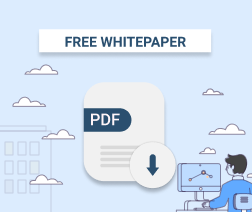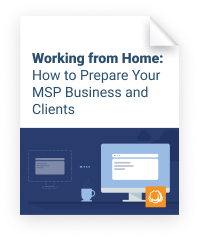One of the biggest challenges in transitioning employees to a work-from-home environment is giving them access to the applications and data that they run on their workstations in the office. It's usually not practical (or secure) for employees to take their physical workstations with them when they switch to working from home. Trying to have employees install work applications on their personal, at-home computers is equally problematic.
Table of Contents
Fortunately, there is an easy solution for quickly giving workers access to their regular workstations when they start working from home: Simply migrate workstations to virtual machines hosted in the cloud, then have employees connect to those virtual machines via RDP in order to maintain business continuity as they work from home.
With the help of backup software like MSP360 Backup, which allows MSPs to back up workstations and restore them to the cloud, converting workstations to cloud-based virtual machines is easier than you may think. So is converting them back to in-office workstations when employees return to a regular work routine.
This article demonstrates how to use MSP360 Backup and Amazon Web Services (AWS) EC2 virtual machines to support employees who need to work from home.
Advantages of cloud-based workstations
You may be thinking, "Couldn't the employees just connect to their regular workstations using a VPN, without migrating them to the cloud"?
They could, but that approach has several drawbacks, especially during times when physical access to the office is limited or impossible:
- It requires a VPN server to be configured in the office.
- VPN client software also needs to be set up and configured correctly on employees' own devices when they work from home. Some employees may struggle to install this software properly on their own.
- If a workstation inside the office freezes or crashes, it is typically impossible to turn it back on without having physical access to the office. (The exception is if you have Wake-on-LAN enabled, but unless you set that up previously on each workstation, it's probably not turned on. Plus, Wake-on-LAN won't help you if a computer freezes in such a way that it is still turned on but is not responding, Wake-on-LAN won't be of use.)
- A power failure in the office would also render all employee workstations unreachable.
- Leaving workstations running in an office when no employees are present poses some security risks. It would be easier for an intruder to gain physical access to workstations when no one is around to guarantee the physical security of the environment.
By migrating workstations to the cloud, you avoid these issues. You don't need a VPN; workers can connect directly to the virtual machine instances. Virtual machines that crash can be restarted remotely through the cloud. Power failures in the cloud are very unlikely. And finally, you don't need to worry about the physical security of the virtual machines.
Setting Up a Remote Workstation With MSP360 and Amazon EC2
Now, let's walk through how to use MSP360 Backup and AWS EC2 to move workstations to the cloud quickly and easily. There are four main steps to the process, which you would perform for each workstation:
- Perform an image-based backup of the workstation.
- Use the image to provision an EC2 instance.
- Connect the EC2 instance to the company network.
- When workers are ready to return to the office, you can create a backup image of the EC2 instance and use it to restore data back to the on-premises workstation.
Create a Workstation Backup Image with MSP360
Start by creating a backup of the workstation using the image-based backup option in MSP360 Backup:

After clicking the image-based backup starts, select Local or Cloud Backup:

Then select Amazon S3 as the storage destination (S3 is the AWS storage service, which we'll use to store the image and then populate an EC2 instance with it):

For Plan name, enter a logical description (such as the name of the workstation you are backing up and the date of the backup):

Next, select which partitions you want to back up. In most cases, you'll want to back up all partitions and all drives. But if your users just certain partitions, you can save space and time by backing up only those.

In the advanced options screen, you can enable filters to exclude unnecessary files or folders from the backup. You can also enable a synthetic full backup if desired. A variety of other options are available; see this article for guidelines on how to use them.
On the encryption and compression screen, specify the encryption password you’d like to use, and select whether you would like to compress data for the backup. Here you can also select the Amazon S3 Storage Class to use. For the use case discussed in this article, the Standard Storage Class is the best option.

In the retention policy screen, you can specify advanced settings for the retention of your data. For the use case discussed in this article, we advise skipping this step; you don’t need data retention because this backup is for a one-time use.

On the backup plan schedule screen, you can either schedule your backup to run at a desired time, or choose to run it manually. For the purposes we’re discussing in this article, you don’t need to run backup plans on a recurring schedule.

In Pre/Post Actions, you can enable actions that will automatically run before or after the backup plan is executed. These actions can be scripts or commandlets.

In the Notification screen, you can set up notifications to receive alerts when the backup has successfully completed. Or, in the event that it fails, you will receive an alert for that, too.

Note that if you are using MSP360 Managed Backup Service, all of the above configuration can be performed remotely through the MBS Web console. See this article for full instructions on remote backup configuration.
Provision Your Amazon EC2 Virtual Machine
After you have configured and created a backup image of the workstation using MSP360 Backup, you’re ready to “recover” the image into an AWS EC2 image. (We put “recover” in quotation marks because you’re not recovering the data per se as it was never lost; you’re simply using the backup image as the basis for provisioning a new virtual machine.)
MSP360 Backup makes this process easy because it provides a feature to perform one-click recovery from a backup image into AWS EC2. Here are the steps.
First, on the main toolbar, click Restore, select “Restore as Amazon EC2 Instance” and don’t forget to select the “Create AMI (Amazon Machine Image)” checkbox.
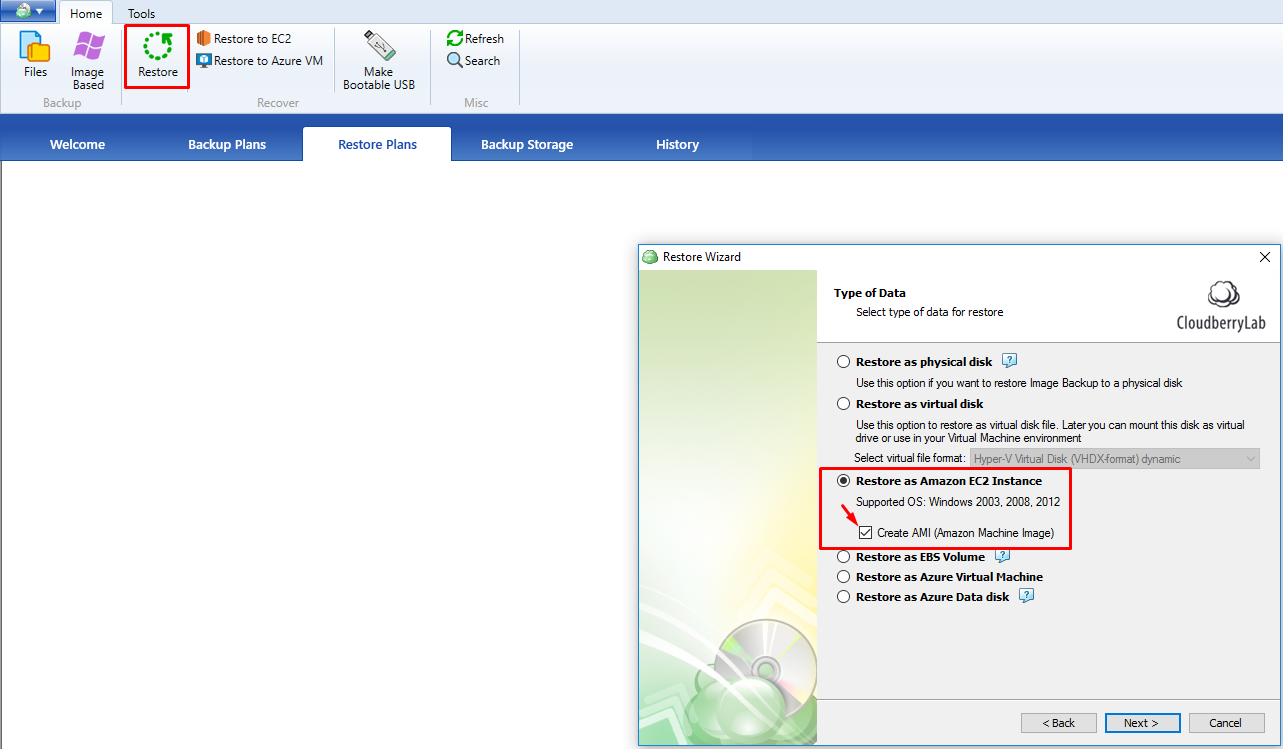
Or, you can simply click Restore to EC2 on the main toolbar.
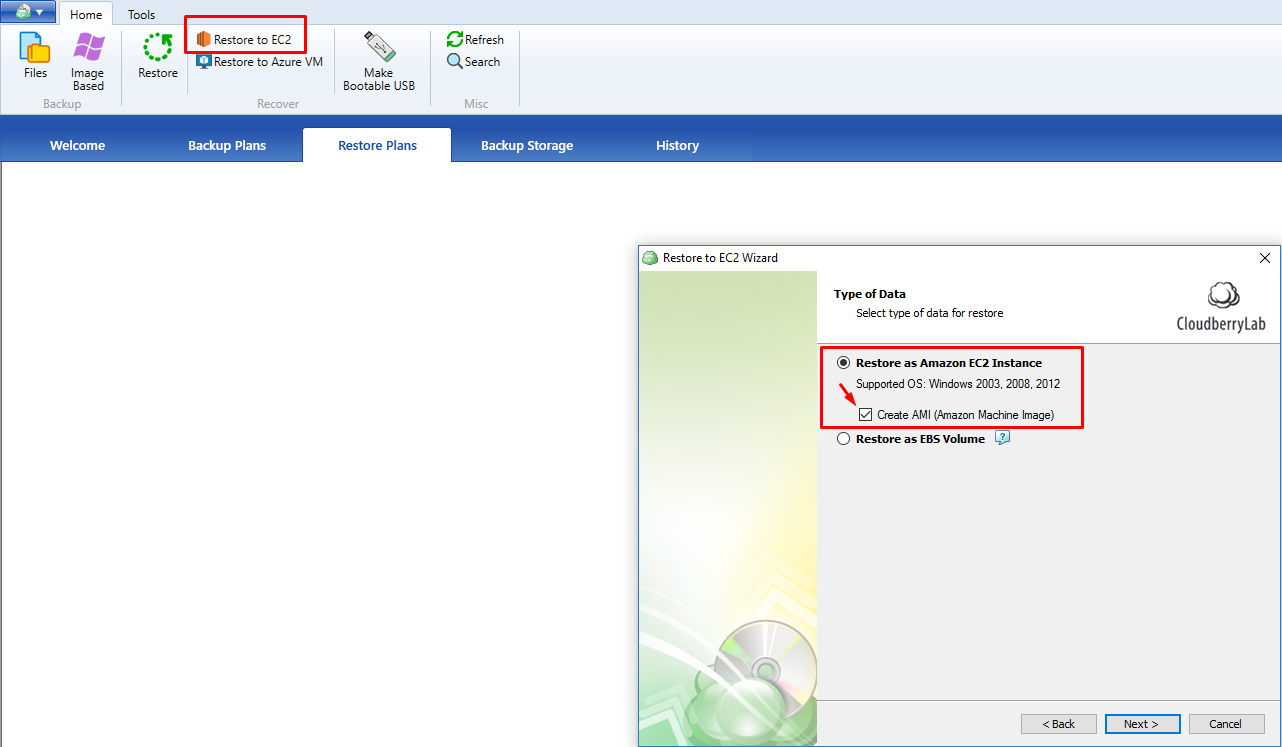
Next, specify your target EC2 instance details. The most important options to consider here include the cloud region used to host your image (choosing a region that is geographically close to the employee who will be using the workstation is best) and the instance type. The instance type should reflect the hardware needs of your workstation. Click here for guidance on which EC2 instance types are available and the features each one offers.
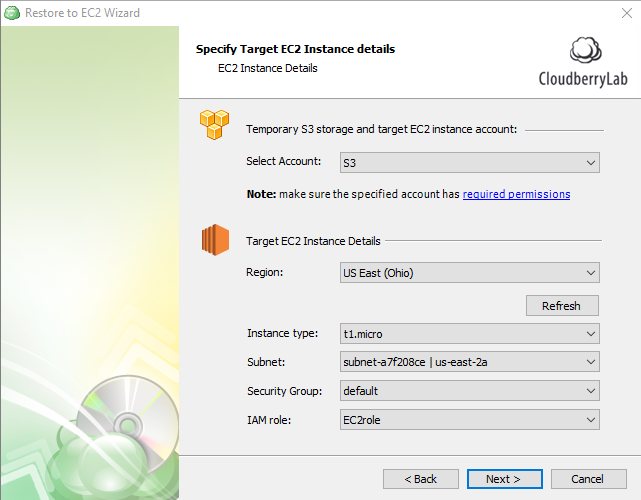
Once your EC2 Instance is configured, you can log into your AWS account to view the virtual machine.
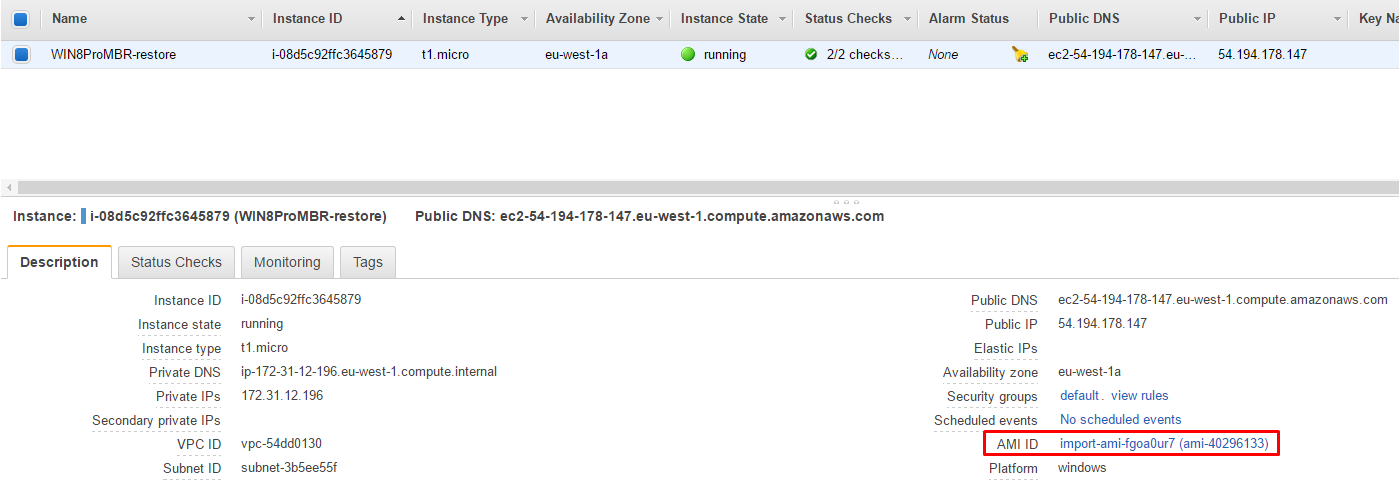
The steps above can also be performed remotely via the MBS Web console if you are using MSP360 Managed Backup Service.
Connect to Amazon EC2 Machine
Now, you’re ready to connect to the virtual machine you created and start using it just as if it were a physical workstation. You can access it from anywhere with Internet connectivity.
To connect, use an RDP client to connect to the public IP address of the virtual machine. Alternatively, for added security, you could choose to connect via the private address using AWS VPN client software.
Connect Amazon EC2 Machine to Your Network
If you need to connect your machine to your corporate network so that it can access resources available only within that network, the easiest and most secure way is to use the AWS site-to-site VPN solution. This will allow you to avoid issues related to domain connectivity.
Moving Back to the Office
When employees are done working from home and can return to their regular workstations in the office, you’ll want to make sure first to sync the workstations back up with the virtual machines that employees used while working from home. You can do this easily by first using MSP360 Backup to create a backup image of the EC2 instance, then performing image-based backup restore to the workstation with a bootable USB.

